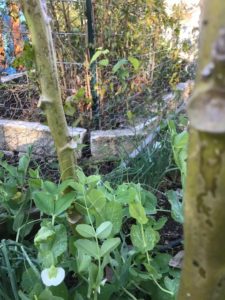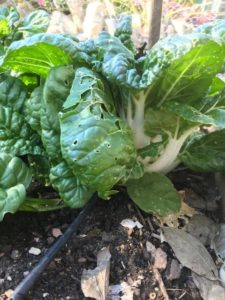
‘Clemson Spineless’ Okra and ‘Oregon Sugar Pod 2’ Peas both growing in December
When is it Winter in Austin Texas?
Winter is a relative term for the December vegetable garden if you live in Austin. The first freeze hasn’t arrived yet, but that doesn’t mean it isn’t lurking around the corner (the average frost date is the first week of December.) It is classic weather for Austin – which means anything can happen. According to NOAA, we have entered into a La Nina weather pattern, which for us here in Central Texas means we can expect warmer than normal temperatures and less than normal rainfall. That’s a good news bad news scenario for me. My okra is still blooming, but what I really want is for it to serve as a trellis for my snow peas, which are also blooming. I guess I’ll just have to stir-fry them together for dinner until that okra-killing freeze finally arrives.

Bug-eaten Pac Choi and Bloomsdale Spinach growing together.
I have another oddball paring over in the greens patch. I interplanted ‘Bloomsdale’ spinach with ‘Joi Choi’ pac choi a few months ago, hoping to hedge my bet when the freeze kills the spinach. The pac choi has traditionally held up to a light frost and will keep growing most of the winter without covering it. This year I have it planted in an area that gets natural frost protection from a rock garden and fruit tree berm. However, if the weather continues to be somewhat mild, the spinach will out compete the pac choi. Another nice problem to have! I just wish the snails and cucumber beetles would bug off though.
Your December Vegetable Garden Checklist
If you’re like me and haven’t really noticed anything slowing down in the garden, here are some more things that should be on the vegetable gardener’s checklist for December:
FERTILIZE
|
- Continue to feed vegetables with fish emulsion or other water-soluble fertilizer every 2 weeks. Soil microbe activity slows down in the cold so supplemental fertilizer may be needed. There is no need to fertilizer any other plant.
|
WATER
|
- Water vegetable beds so that plantings do not dry out. Check the soil first, irrigate only if the soil is dry a few inches below the surface or in newly established seedbeds.
|
PLANT
|
- Grow your own seedlings of broccoli, bok choy, mustard, Swiss chard or other greens so you will have a continual supply of transplants for setting out in January and February. It takes 5-6 weeks to reach transplant size, so plan accordingly. Start them in the house or greenhouse but be sure to harden them off before transplanting and be prepared to protect from frost.
- Start shopping for seed potatoes and order for the February planting season.
- Say goodbye to your basil (if you haven’t already done so) and plant some cool weather, fuss-free herbs like cilantro, parsley, oregano, sage, or winter savory.
- You might also consider starting your tomatoes this month. The goal is to have a gallon size plant ready to transplant the first part of March.
|
SOIL
|
- Use mild days to turn compost and build up mulch.
|
DISEASES/PESTS TO LOOK FOR
|
- Cabbage loopers, aphids, snails/slugs, and some beetles can remain active all winter. Protect plants from damage and insulate from freezing weather with a layer of row cover. This can be left on all winter. Anchor the fabric in several places with u-shaped pins, bricks, stones or sandbags. Another option is to lay 4-6 foot lengths of heavy t-posts or wooden boards along the long edge of the row. They are easy to remove if you want to lift up a section of row cover to periodically check the progress of your plants.
|
MAINTENANCE
|
- Keep up with weeds while they are young, before they have a chance to put down roots. A sharp hoe or cultivator makes quick work in vegetable beds.
- Take advantage of mild winter days to tidy up the tool shed and the greenhouse. Remove rust from tools and apply a light coat of machine oil for protection. Remove annuals that were killed or burned by frost.
- Pay attention to the forecast. If temperatures are predicted to fall below 28° cover plants with row cover, securing edges with soil, bricks, rocks or pins.
|
HARVEST
|
- Keep your vegetable consumption high this winter as you continue to harvest Swiss chard, kale, collards and lettuce. Use a “cut and come again” strategy. You’ll be surprised how fast everything grows.
- Cut or twist the leafy tops off of turnips, beets, radishes and carrots before storing, and don’t overlook the culinary potential of those
leafy greens. They are totally edible and nutritious, especially when harvested fresh from the garden. They may have a bitter bite
when eaten unadorned in their natural state, but their flavor is transformed when chopped up and incorporated into soups, casseroles,
vegetable sautés or dips. Carrot tops make a tasty pesto for adventurous eaters.
|
PLANNING
|
- Take some time to sit down with garden notes and graph paper or a computer app and plan your vegetable garden for next year. Peruse seed catalogs, and place your order for the spring season while they still have plenty of inventory.
- Get your menus set for January 1. I go through my stash of homegrown dried black-eyed peas to make sure I have enough. If needed, I try to shop early and pick up extra now before the local grocery store sells out. I don’t want to miss out fixing a big pot of black-eyed peas (for good luck) and collard greens (for prosperity) on New Year’s Day, (along with a nice slab of hot cornbread.) Lift your spoon and let’s hope for better days in 2022.
|
Additional Resources
Watch the Vegetable Gardening in Central Texas Webinar
Recommended Vegetable Varieties for Travis County
Vegetable Seed Sources
Vegetable Gardening in Austin
Plant Rotations, Successions and Intercropping
Rootknot Nematode Management
Sustainable Food Center Farmers Markets
Texas Farmers Markets
Monthly Gardening Calendar for Austin and Central Texas
About Sheryl Williams
 Sheryl Williams has been a Travis County Master Gardener since 2010 and currently works as the Horticulture Program Assistant at Texas A&M AgriLife Extension – Travis County. She was introduced to gardening by her mom and grandma and has been an avid vegetable gardener most of her life. Sheryl believes that there is nothing more satisfying than growing and preparing your own food. She likes gardening in Austin year round and concedes that means pulling weeds every day. She practices organic gardening principles and enjoys the challenge of outsmarting garden pests. Occasionally she loses these battles, but doesn’t mind sharing a good meal.
Sheryl Williams has been a Travis County Master Gardener since 2010 and currently works as the Horticulture Program Assistant at Texas A&M AgriLife Extension – Travis County. She was introduced to gardening by her mom and grandma and has been an avid vegetable gardener most of her life. Sheryl believes that there is nothing more satisfying than growing and preparing your own food. She likes gardening in Austin year round and concedes that means pulling weeds every day. She practices organic gardening principles and enjoys the challenge of outsmarting garden pests. Occasionally she loses these battles, but doesn’t mind sharing a good meal.


 Sheryl Williams has been a Travis County Master Gardener since 2010 and currently works as the Horticulture Program Assistant at Texas A&M AgriLife Extension – Travis County. She was introduced to gardening by her mom and grandma and has been an avid vegetable gardener most of her life. Sheryl believes that there is nothing more satisfying than growing and preparing your own food. She likes gardening in Austin year round and concedes that means pulling weeds every day. She practices organic gardening principles and enjoys the challenge of outsmarting garden pests. Occasionally she loses these battles, but doesn’t mind sharing a good meal.
Sheryl Williams has been a Travis County Master Gardener since 2010 and currently works as the Horticulture Program Assistant at Texas A&M AgriLife Extension – Travis County. She was introduced to gardening by her mom and grandma and has been an avid vegetable gardener most of her life. Sheryl believes that there is nothing more satisfying than growing and preparing your own food. She likes gardening in Austin year round and concedes that means pulling weeds every day. She practices organic gardening principles and enjoys the challenge of outsmarting garden pests. Occasionally she loses these battles, but doesn’t mind sharing a good meal.
